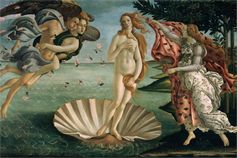Sandro Botticelli

Sandro Botticelli or Il Botticello ("The Little Barrel") was an Italian painter of the Florentine school during the Early Renaissance. Less than a hundred years later, this movement, under the patronage of Lorenzo de' Medici, was characterized by Giorgio Vasari as a "golden age", a thought, suitably enough, he expressed at the head of his Vita of Botticelli. His posthumous reputation suffered until the late 19th century; since then his work has been seen to represent the linear grace of Early Renaissance painting, and The Birth of Venus and Primavera rank now among the most familiar masterpieces of Florentine art.
Details of Botticelli's life are sparse, but we know that he became an apprentice when he was about fourteen years old, which would indicate that he received a fuller education than did other Renaissance artists. Vasari reported that he was initially trained as a goldsmith by his brother Antonio. Probably by 1462 he was apprenticed to Fra Filippo Lippi; many of his early works have been attributed to the elder master, and attributions continue to be uncertain. Influenced also by the monumentality of Masaccio's painting, it was from Lippi that Botticelli learned a more intimate and detailed manner. As recently discovered, during this time, Botticelli could have traveled to Hungary, participating in the creation of a fresco in Esztergom, ordered in the workshop of Fra Filippo Lippi by Vit Jos, then archbishop of Hungary.
By 1470 Botticelli had his own workshop. Even at this early date his work was characterized by a conception of the figure as if seen in low relief, drawn with clear contours, and minimizing strong contrasts of light and shadow which would indicate fully modeled forms.
The masterworks Primavera (ca. 1478) and The Birth of Venus (ca. 1485) were both seen by Vasari at the villa of Lorenzo di Pierfrancesco de' Medici at Castello in the mid-16th century, and until recently it was assumed that both works were painted specifically for the villa. Recent scholarship suggests otherwise: the Primavera was painted for Lorenzo's townhouse in Florence, and The Birth of Venus was commissioned by someone else for a different site. By 1499 both had been installed at Castello.
In these works the influence of Gothic realism is tempered by Botticelli's study of the antique. But if the painterly means may be understood, the subjects themselves remain fascinating for their ambiguity. The complex meanings of these paintings continue to receive scholarly attention, mainly focusing on the poetry and philosophy of humanists who were the artist's contemporaries. The works do not illustrate particular texts; rather, each relies upon several texts for its significance. Of their beauty, characterized by Vasari as exemplifying "grace", and by John Ruskin as possessing linear rhythm, there can be no doubt.
The Adoration of the Magi for Santa Maria Novella (ca. 1475-1476, now at the Uffizi) contains the portraits of Cosimo de' Medici ("the finest of all that are now extant for its life and vigor", his grandson Giuliano de' Medici, and Cosimo's son Giovanni. The quality of the scene was hailed by Vasari as one of Botticelli's pinnacles.
In 1481, Pope Sixtus IV summoned Botticelli and other prominent Florentine and Umbrian artists to fresco the walls of the Sistine Chapel. The iconological program was the supremacy of the Papacy. Sandro's contribution was moderately successful. He returned to Florence, and "being of a sophisticed turn of mind, he there wrote a commentary on a portion of Dante and illustrated the Inferno which he printed, spending much time over it, and this abstention from work led to serious disorders in his living." Thus Vasari characterized the first printed Dante (1481) with Botticelli's decorations; he could not imagine that the new art of printing might occupy an artist.
In the mid-1480's Botticelli worked on a major fresco cycle with Perugino, Ghirlandaio, and Filippino Lippi, for Lorenzo the Magnificent's villa near Volterra; in addition he painted many frescoes in Florentine churches.
In 1491 Botticelli served on a committee to decide upon a facade for the Florence Duomo. In 1502 he was accused of sodomy, though charges were later dropped. In 1504 he was a member of the committee appointed to decide where Michelangelo's David would be placed. His later work, especially as seen in a series on the life of Saint Zenobius, witnessed a diminution of scale, expressively distorted figures, and a non-naturalistic use of color reminiscent of the work of Fra Angelico nearly a century earlier.
In later life, Botticelli was one of Savonarola's followers, though the full extent of Savonarola's influence is uncertain. The story that he burnt his own paintings on pagan themes in the notorious "Bonfire of the Vanities" is not told by Vasari, who asserts that of the sect of Savonarola "he was so ardent a partisan that he was thereby induced to desert his painting, and, having no income to live on, fell into very great distress. For this reason, persisting in his attachment to that party, and becoming a Piagnone he abandoned his work.". Botticelli biographer Ernst Steinman searched for the artist's psychological development through his Madonnas. In the "deepening of insight and expression in the rendering of Mary's physiognomy", Steinman discerns proof of Savonarola's influence over Botticelli. This means that the biographer needed to alter the dates of a number of Madonnas to substantiate his theory; specifically, they are dated ten years later than before. Steinman disagrees with Vasari's assertion that Botticelli produced nothing after coming under the influence of Girolamo Savonarola. Steinman believes the spiritual and emotional Virgins rendered by Sandro follow directly from the teachings of the Dominican monk.
Earlier, Botticelli had painted an Assumption of the Virgin for Matteo Palmieri in a chapel at San Pietro Maggiore in which, it was rumored, both the patron who dictated the iconic scheme and the painter who painted it, were guilty of unidentified heresy, a delicate requirement in such a subject. The heretical notions seem to be Gnostic in character:
By the side door of San Piero Maggiore he did a panel for Matteo Palmieri, with a large number of figures representing the Assumption of Our Lady with zones of patriarchs, prophets, apostles, evangelists, martyrs, confessors, doctors, virgins, and the orders of angels, the whole from a design given to him by Matteo, who was a worthy and educated man. He executed this work with the greatest mastery and diligence, introducing the portraits of Matteo and his wife on their knees. But although the great beauty of this work could find no other fault with it, said that Matteo and Sandro were guilty of grave heresy. Whether this is true or not, I cannot say. (Giorgio Vasari)
This is a common misconception based on an error by Vasari. The painting referred to here, now in the National Gallery in London, is by the artist Botticini. Vasari confused their similar sounding names.
Botticelli was already little employed in 1502; after his death his reputation was eclipsed longer and more thoroughly than that of any other major European artist. His paintings remained in the churches and villas for which they had been created, his frescoes in the Sistine Chapel upstaged by Michelangelo's. The first nineteenth century art historian to have looked with satisfaction at Botticelli's Sistine frescoes was Alexis-Franis Rio. Through Rio Mrs. Jameson and Sir Charles Eastlake were alerted to Botticelli, but, while works by his hand began to appear in German collections, both the Nazarenes and the Pre-Raphaelite Brotherhood ignored him. Walter Pater created a literary picture of Botticelli, who was then taken up by the Aesthetic movement. The first monograph on the artist was published in 1893; then, between 1900 and 1920 more books were written on Botticelli than any other painter.






























































